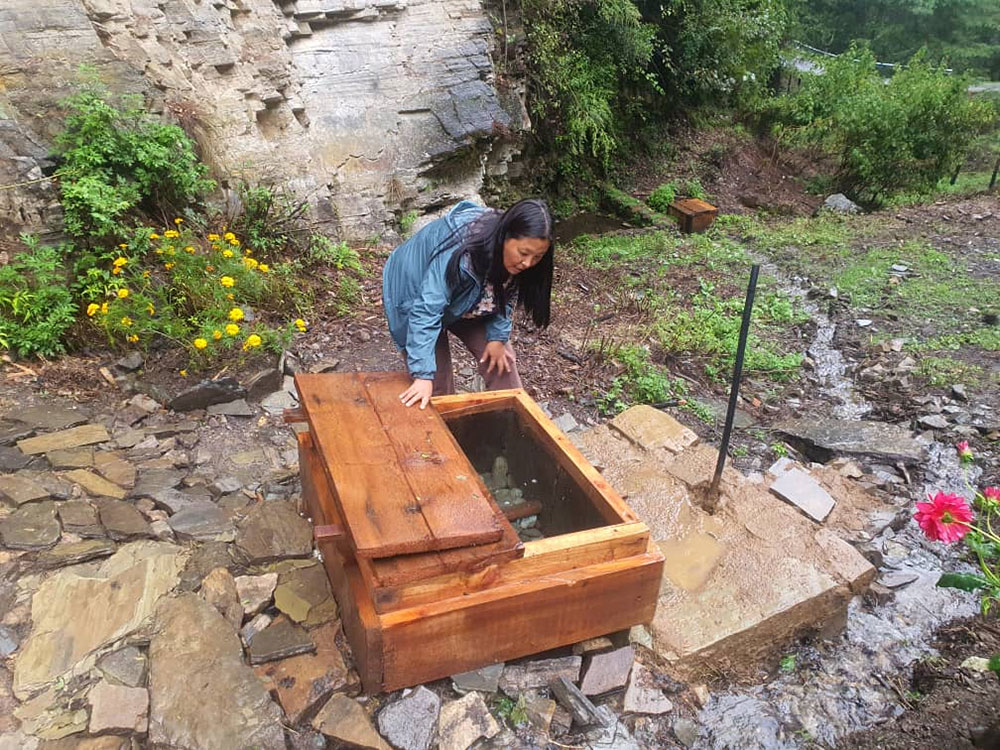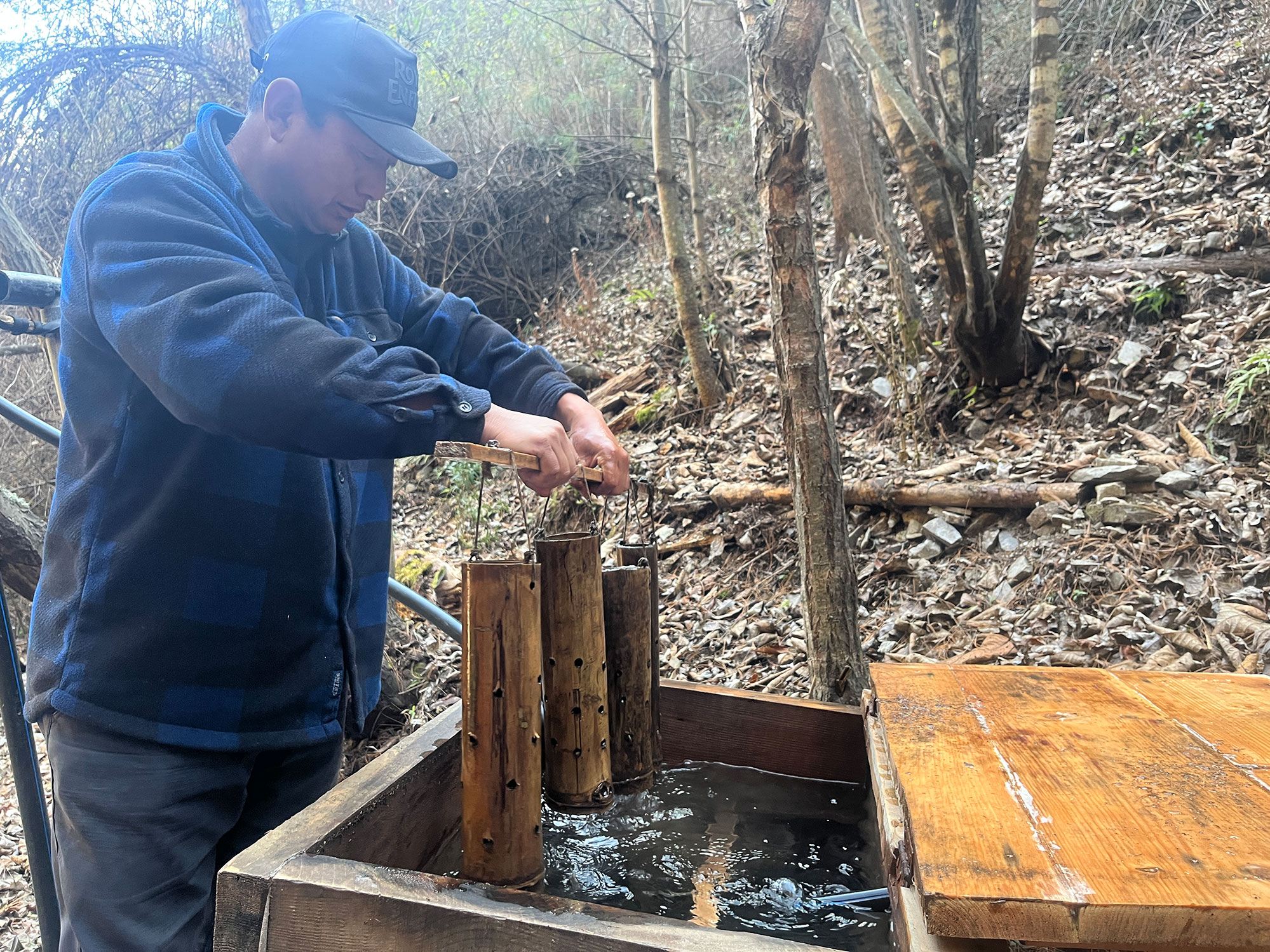Dechen Dolkar
Sangay Tshering, a 54-year-old resident of Dogar gewog in Paro, never cultivated so much chilli in his entire life as he did this fall. Until last year, his family only cultivated a few rows of chillies and some vegetables for self consumption owing to the acute water shortage in the village.
Sangay Tshering from Tango village said that for the past decade, water sources were limited and their volumes minimal, leading to scarcity.
The nature-based solutions drinking water project, implemented by the Tarayana Foundation in collaboration with the World Wildlife Fund (WWF)-Bhutan, changed everything.

Villagers are trained to manage the water sources
Last year, the Nu 1.3M project benefited around 254 households in the gewog, as well as 250 monks of Serlung Gonpa and students from Dawakha Middle Secondary School, providing adequate clean drinking water.
The project involved installing a total capacity of 109,700-liter water reservoir tanks using traditional water filtration techniques and laying 12.1km of drinking water pipes across 10 villages, including Tango, Sali, Tashigang, Lhajakha, Gomchu, Dawakha Lhagay, Serlung Gonpa, and Tango Sawmill villages.
Before the implementation of the springshed intervention project, the community faced water scarcity, with sources gradually drying up. The project focused on reviving and recharging water sources through trench pits at potential sites, effectively increasing water volumes.
With the introduction of nature-based solutions, 214 trench pits were created at water sources, resulting in overflowing water tanks. He said that despite winter challenges where water sources would typically dry up, the initiative has ensured a continuous water supply, benefitting four villages with 34 households.
Before the project, Sangay Tshering said households struggled with water scarcity, resorting to storing water in containers. The initiative has not only alleviated this issue but has also allowed for water utilisation in gardening.
“Now I have ventured into large-scale vegetable farming, moving beyond subsistence cultivation.”
Tashi, 61-year-old, the chairperson of the Water User Group from Tashigang village, said that the overflow of water tanks is due to the nature-based solution project. He said that wooden troughs are installed to be revived for sustainability which will last for more than 40 to 50 years with continuous water flow. “The active involvement of all households in the project has eliminated the need for water storage containers.”
Kinzang Wangchuk, a 30-year-old teacher from Serlung Gonpa, said that the monastery used to face water scarcity even when it had only 25 monks. With more than 100 monks joining, water shortage issues persisted until the project’s intervention.
He said that the water source was not maintained properly, with waste lying around the sources. Now, the sources are well-protected with nature-based innovations, ensuring cleanliness directly from the sources.
“The improved water sources have allowed for better cleanliness and hygiene in the monastery, benefiting over 250 monks,” he said.
Monks at the monastery said that they could now bathe regularly and their toilets are clean.
Tarayana’s Project Officer, Karma Euden said that this project created water flows accessible to animals, curbing human-wildlife conflicts and promoting a balanced coexistence.
The Director of the Program at the Tarayana Foundation, Roseleen Gurung, said that the project was initiated to address the water issues faced by rural communities impacted by climate change. The implementation involved an assessment of springshed on drying water, introducing a new concept proven successful in the Himalayan countries of Nepal and Sikkim.
She said that while conveying the springshed concept to the community during implementation posed challenges, the project successfully addressed water scarcity by focusing on the conservation and protection of recharge areas.
She said that in the past, water resource management efforts did not pay much attention to the conservation and protection of recharging areas as an important aspect of water sources.
She mentioned that the conservation mainly focused on water protecting the point where springs discharged, by physically fencing off. While it is crucial to keep the water collection point clean and free from pathogens, that is not where the problem of water quantity is best addressed.
“The purpose of the project is to go beyond what has been done to protect water sources and explore the potential recharge zones of drying lakes and springs based on the best science available at the time,” She said.
Roseleen Gurung also said that empowering communities through initiatives like Projects is a priority for the Foundation, providing means and instruments for autonomous water supply management.
She said that by encouraging appropriate water management techniques, the foundation aims to support environmental conservation through ecosystem-based adaptation, including the implementation of eco-friendly technologies and safeguarding water sources.
The project is funded by the International Climate Initiative (IKI): an important part of the German government’s international climate finance commitment implemented closely with the Federal Ministry for the Environment, Nature Conservation, Nuclear Safety and Consumer Protection (BMUV).
The project aims to benefit at least 18 water harvesting schemes in the landscape.
The project supported the springshed assessment of four springs and one lake in Dogar gewog and formed water user groups.
Through the formation of the water-user group for sustainability, the communities have been trained on managing water sources.


